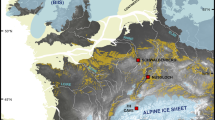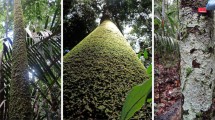Abstract
Stratospheric ozone screens the Earth’s surface from harmful ultraviolet-B radiation. Concentrations of stratospheric ozone are governed by a variety of natural and anthropogenic factors, including solar cycles1, volcanic aerosols2, ozone-depleting substances3 and climate change4. However, assessing this variability before instrumental records has proved difficult owing to the lack of a well-constrained proxy5. Here, we use microspectroscopy to analyse the chemical composition of herbarium samples of clubmoss (Lycophyta) spores originating from high- and low-latitude localities, where they were exposed to different ultraviolet-B histories. We show that the concentration of two ultraviolet-B-absorbing compounds in the walls of high-northern- and southern-latitude spores is strongly regulated by historical variations in ultraviolet-B radiation. Conversely, we find little change in the concentration of these compounds in spores originating from tropical Ecuador, where ultraviolet levels have remained relatively stable. Using spores from Greenland, we reconstruct past (1907–1993) changes in ozone concentration and ultraviolet-B flux; we reveal strong similarities between spore-wall reconstructions, and independent instrumental records6 and model results7. Our findings suggest that ultraviolet-B-absorbing compounds in plant spore walls have the potential to act as a proxy for past changes in terrestrial ultraviolet-B radiation and stratospheric ozone. The chemical signature of plant spore walls in herbaria, and possibly also in sedimentary and ice-core archives, may therefore prove valuable for reconstructing past variations in stratospheric ozone and their connections with changes in solar radiation and climate.
This is a preview of subscription content, access via your institution
Access options
Subscribe to this journal
Receive 12 print issues and online access
$259.00 per year
only $21.58 per issue
Buy this article
- Purchase on Springer Link
- Instant access to full article PDF
Prices may be subject to local taxes which are calculated during checkout




Similar content being viewed by others
References
Rozema, J., van Geel, B., Bjorn, L. O., Lean, J. & Madronich, S. Paleoclimate: Toward solving the UV puzzle. Science 296, 1621–1622 (2002).
Tabazadeh, A., Drdla, K., Schoeberl, M. R., Hamill, P. & Toon, O. B. Arctic ‘ozone hole’ in a cold volcanic stratosphere. Proc. Natl Acad. Sci. 99, 2609–2612 (2002).
Farman, J. C., Gardiner, B. G. & Shanklin, J. D. Large losses of total ozone in Antarctica reveal seasonal ClOx/NOx interaction. Nature 315, 207–210 (1985).
Goutail, F. et al. Early unusual ozone loss during the Arctic winter 2002/2003 compared to other winters. Atmos. Chem. Phys. 5, 665–677 (2005).
World Meteorological Organisation (WMO). Scientific assessment of ozone depletion: 2006 Global Ozone Research and Monitoring Project-Report No. 50 (Geneva, 2007).
Hansen, G. & Svenøe, T. Multi-linear regression analysis of the 65-year Tromsø total ozone series. J. Geophys. Res. 110, D10103 (2005).
Lindfors, A., Holmgren, B. & Hansen, G. Long-term erythemal UV at Abisko and Helsinki estimated using total ozone, sunshine duration, and snow depth. Remote Sens. Clouds Atmos. XI, Proc. SPIE 6362, doi:10.1117/12.689742 (2006).
Herman, J. R., Bhartia, P.K., Ziemke, J., Ahmad, Z.N. & Larko, D. UV-B increases (1979–1992) from decreases in total ozone. Geophys. Res. Lett. 23, 2117–2120 (1996).
Vogler, C., Brönnimann, S., Staehelin, J. & Griffin, R. E. M. Dobson total ozone series of Oxford: Re-evaluation and applications. J. Geophys. Res. 112, D20116 (2007).
Dobson, G. M. B. & Harrison, D. N. Measurements of the amount of ozone in the Earth’s atmosphere and its relation to other geophysical conditions. Proc. Phys. Soc. Lond. A 110, 660–693 (1926).
Vogler, C., S., Brönnimann, S. & Hansen, G. Re-evaluation of the 1950–1962 total ozone record from Longyearbyen, Svalbard. Atmos. Chem. Phys. 6, 4763–4773 (2006).
Searles, P. S., Flint, S. D. & Caldwell, M. M. A meta-analysis of plant field studies simulating stratospheric ozone depletion. Oecologia 127, 1–10 (2001).
Xiong, F. S. & Day, T. A. Effect of solar ultraviolet-B radiation during springtime ozone depletion on photosynthesis and biomass production of Antarctic vascular plants. Plant Phys. 125, 738–751 (2001).
Ruhland, C. T. & Day, T. A. Size and longevity of seed banks in Antarctica and the influence of ultraviolet-B radiation on survivorship, growth and pigment concentrations of Colobanthus quitensis seedlings. Environ. Exp. Bot. 45, 143–154 (2001).
Newsham, K. K. UV-B radiation arising from stratospheric ozone depletion influences the pigmentation of the Antarctic moss Andreaea regularis. Oecologia 135, 327–331 (2003).
Markham, K. R., Franke, A., Given, D. R. & Brownsey, P. Historical Antarctic ozone trends from herbarium specimen flavonoids. Bull. Liais. Group Polyphenols 15, 230–235 (1990).
Blokker, P., Yeloff, D., Boelen, P., Broekman, R. A. & Rozema, J. Development of a proxy for past surface UV-B irradiation: A thermally assisted hydrolysis and methylation py-GC/MS method for the analysis of pollen and spores. Anal. Chem. 77, 6026–6031 (2005).
Rozema, J. et al. UV-B absorbance and UV-B absorbing compounds (para-coumaric acid) in pollen and sporopollenin: the perspective to track historic UV-B levels. J. Photochem. Photo. B. 62, 108–117 (2001).
Watson, J. S. et al. Rapid determination of spore chemistry using thermochemolysis gas chromatography–mass spectrometry and micro-Fourier transform infrared spectroscopy. Photochem. Photobiol. Sci. 6, 689–694 (2007).
Alonso-Amelot, M. E., Oliveros-Bastidas, A. & Calcagno-Pisarelli, M. P. Phenolics and condensed tannins of high altitude Pteridium arachnoideum in relation to sunlight exposure, elevation, and rain regime. Biochem. Syst. Ecol. 35, 1–10 (2007).
Piazena, H. The effect of altitude upon the solar UV-B and UV-A irradiance in the tropical Chilean. Sol. Energy 57, 133–140 (1996).
Weatherhead, B., Tanskanen, A. & Stevermer, A. in Arctic Climate Impact Assessment (eds Corell, R. et al.) 151–182 (Cambridge Univ. Press, Cambridge, 2005).
WMO (World Meteorological Organization), Scientific Assessment of Ozone Depletion: 1998, WMO Global Ozone Research and Monitoring Project-Report No. 44 (Geneva, 1998).
McKenzie, R. L., Aucamp, P. J., Bais, A. F., Björn, L. O. & Ilyas, M. Changes in biologically-active ultraviolet radiation reaching the Earth’s surface. Photochem. Photobiol. Sci. 6, 218–231 (2007).
Draper, N. R. & Smith, H. Applied regression analysis 2nd edn (Wiley, New York, 1987).
Jones, P. D., Jonsson, T. & Wheeler, D. Extension to the North Atlantic Oscillation using early instrumental pressure observations from Gibraltar and south-west Iceland. Int. J. Clim. 17, 1433–1450 (1997).
Orsolini, Y. J. & Doblas-Reyes, F. J. Ozone signatures of climate patterns over the Euro-Atlantic sector in the spring. Q. J. R. Meteorol. Soc. 329, 3251–3263 (2003).
Hahlbrock, K. & Scheel, D. Physiology and molecular-biology of phenylpropanoid metabolism. Annu. Rev. Plant Physiol. Plant Mol. Biol. 40, 347–369 (1989).
Lean, J. Evolution of the sun’s spectral irradiance since the Maunder minimum. Geophys. Res. Lett. 27, 2425–2428 (2000).
Bubert, H., Lambert, J., Steuernagel, S., Ahlers, F. & Wiermann, R. Continuous decomposition of sporopollenin from pollen of Typha angustifolia L. by acidic methanolysis. Z. Naturforsch. 57, 1035–1041 (2002).
Acknowledgements
We thank F. I. Woodward and W. P. Quick for critical comments on an earlier version of the manuscript, and D. Cameron and P. Mitchell for statistical assistance. We are also grateful to the following individuals for herbarium loans: H. Peat (British Antarctic Survey); B. Øllgaard (University of Aarhus); O. Ryding (The Botanical Museum, Copenhagen). We gratefully acknowledge financial support through a Natural Environment Research Council (NERC) studentship and CASE award to W.T.F. from Thermo Fisher Scientific and an NERC award (NER/A/S/2002/00865) and a Leverhulme Trust Early Career Fellowship to B.H.L. (ECF/2006/0492).
Author information
Authors and Affiliations
Corresponding author
Supplementary information
Supplementary Information
Supplementary figures S1-S2 and tables S1-S4 (PDF 223 kb)
Rights and permissions
About this article
Cite this article
Lomax, B., Fraser, W., Sephton, M. et al. Plant spore walls as a record of long-term changes in ultraviolet-B radiation. Nature Geosci 1, 592–596 (2008). https://doi.org/10.1038/ngeo278
Received:
Accepted:
Published:
Issue Date:
DOI: https://doi.org/10.1038/ngeo278
This article is cited by
-
Global ozone depletion and increase of UV radiation caused by pre-industrial tropical volcanic eruptions
Scientific Reports (2019)
-
Ginkgo leaf cuticle chemistry across changing pCO2 regimes
PalZ (2019)
-
Impaired photosynthesis and increased leaf construction costs may induce floral stress during episodes of global warming over macroevolutionary timescales
Scientific Reports (2018)
-
Chemical characterization and identification of Pinaceae pollen by infrared microspectroscopy
Planta (2018)
-
Pollen and spores as biological recorders of past ultraviolet irradiance
Scientific Reports (2016)



